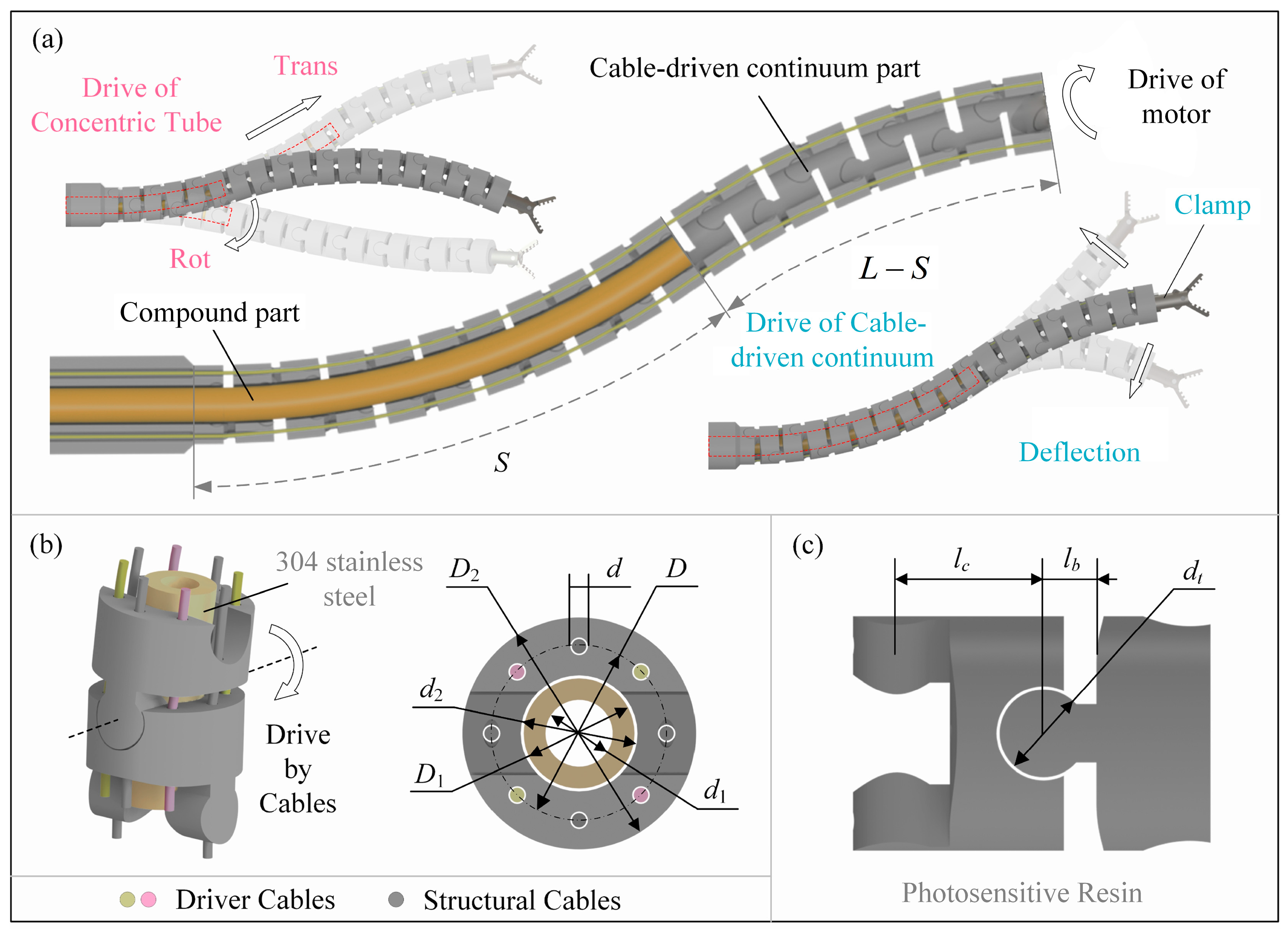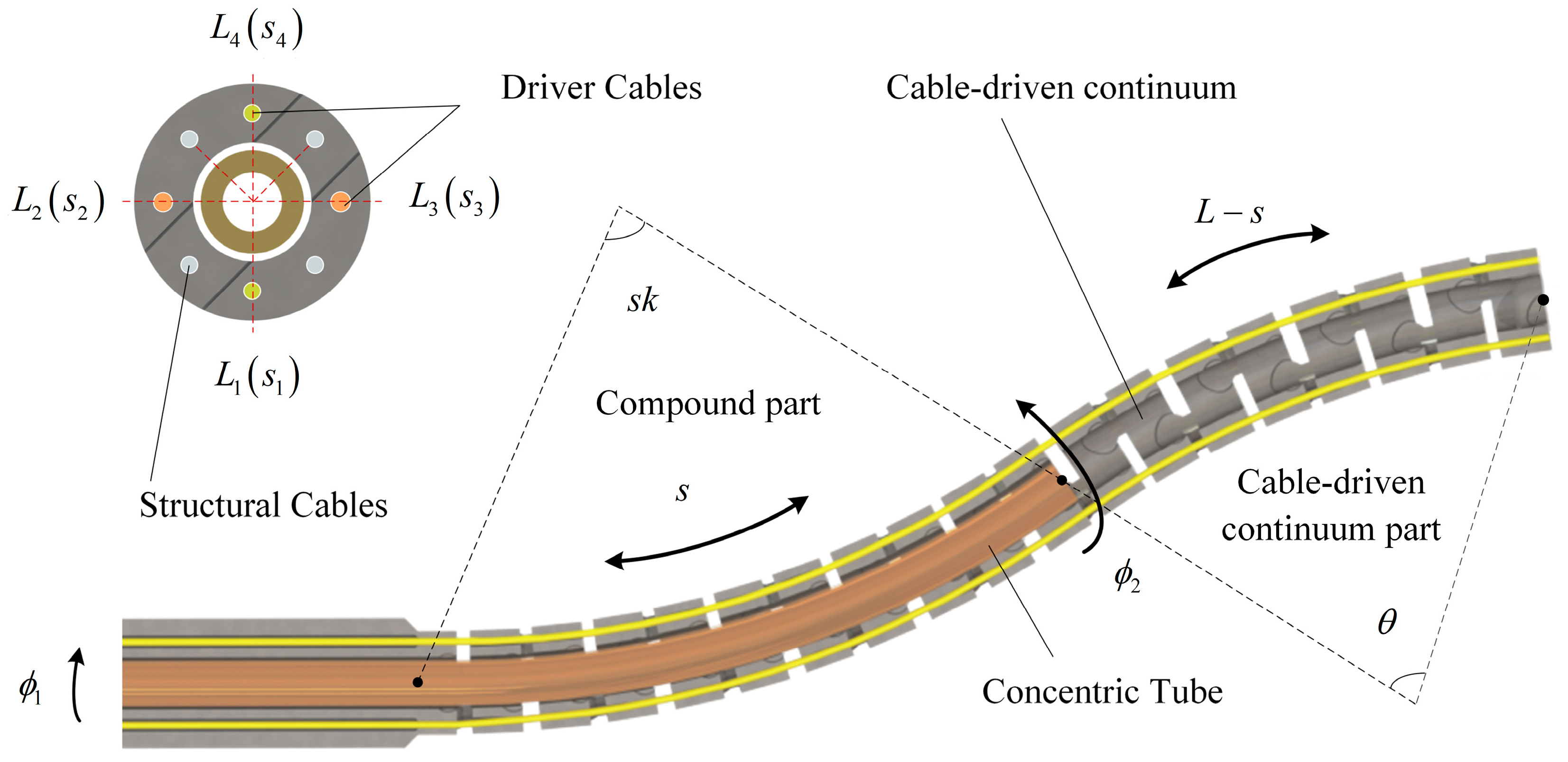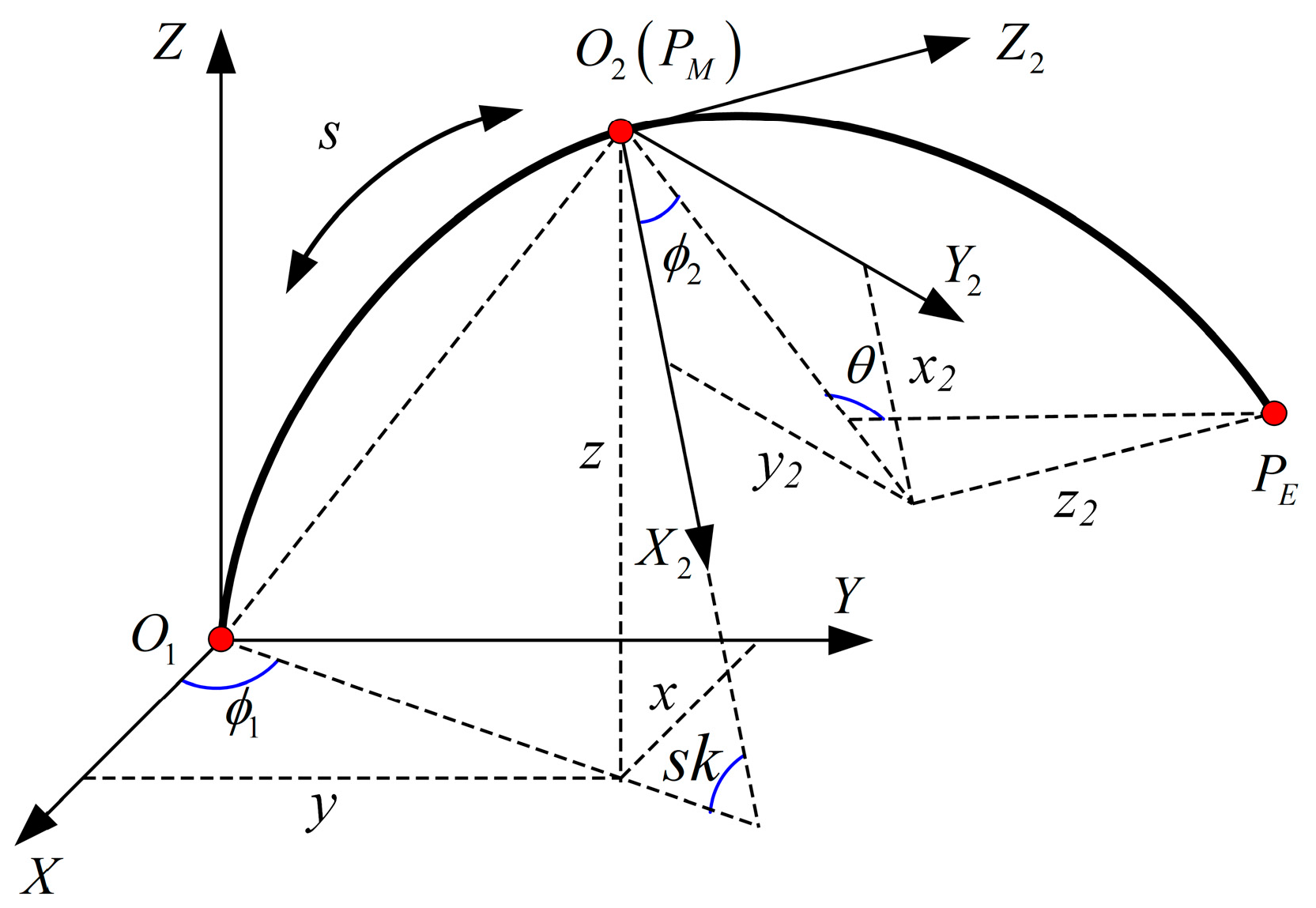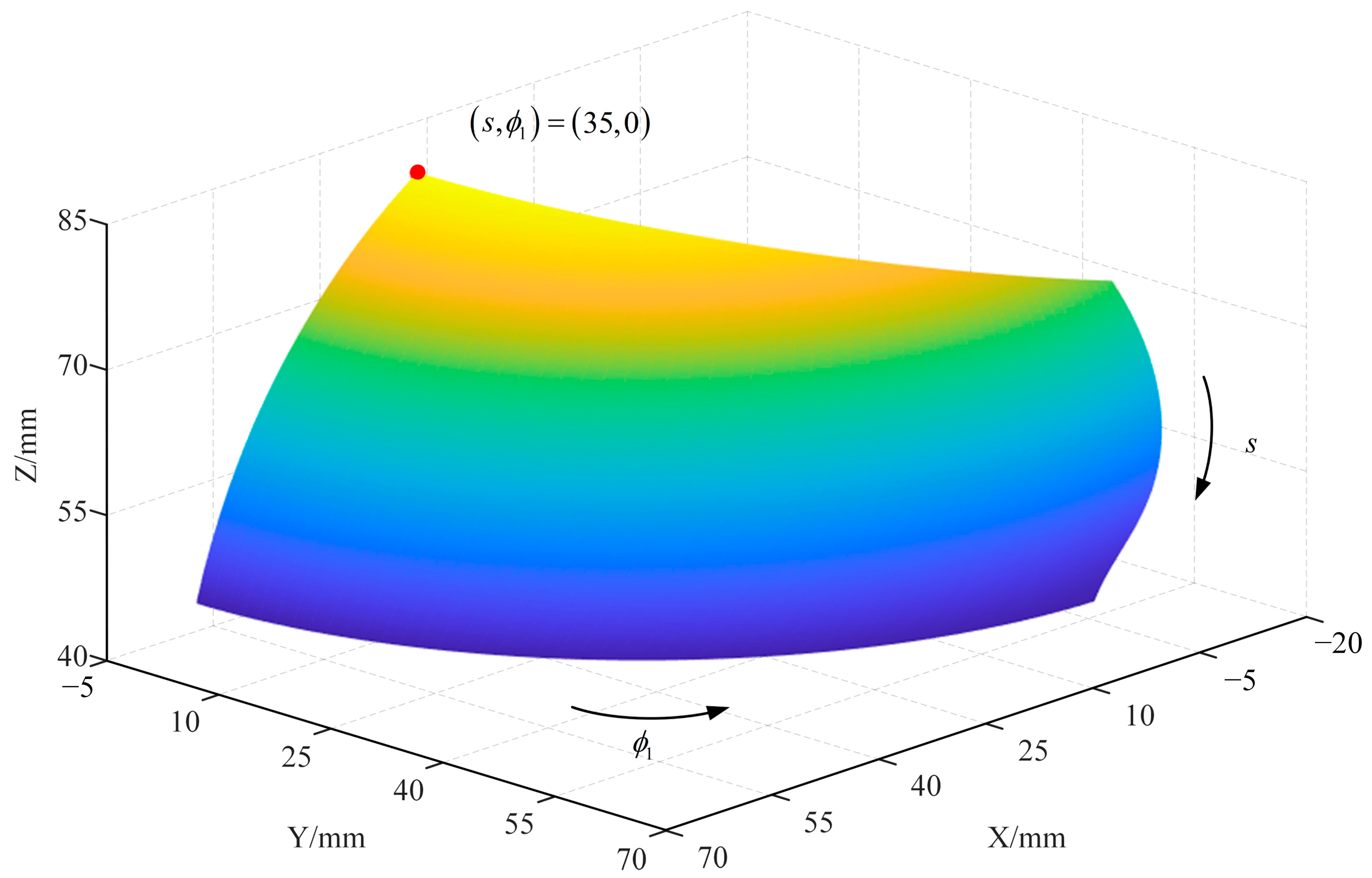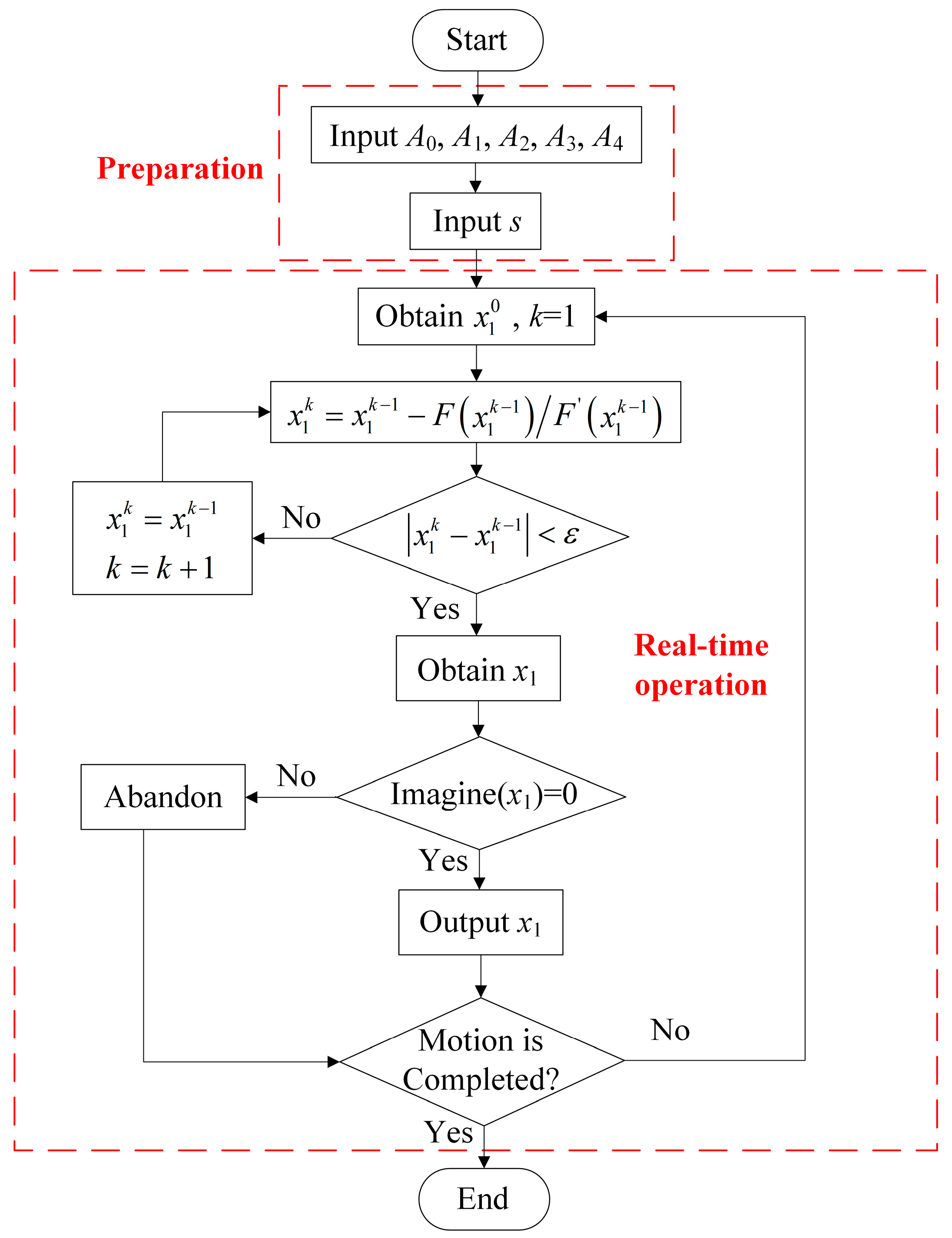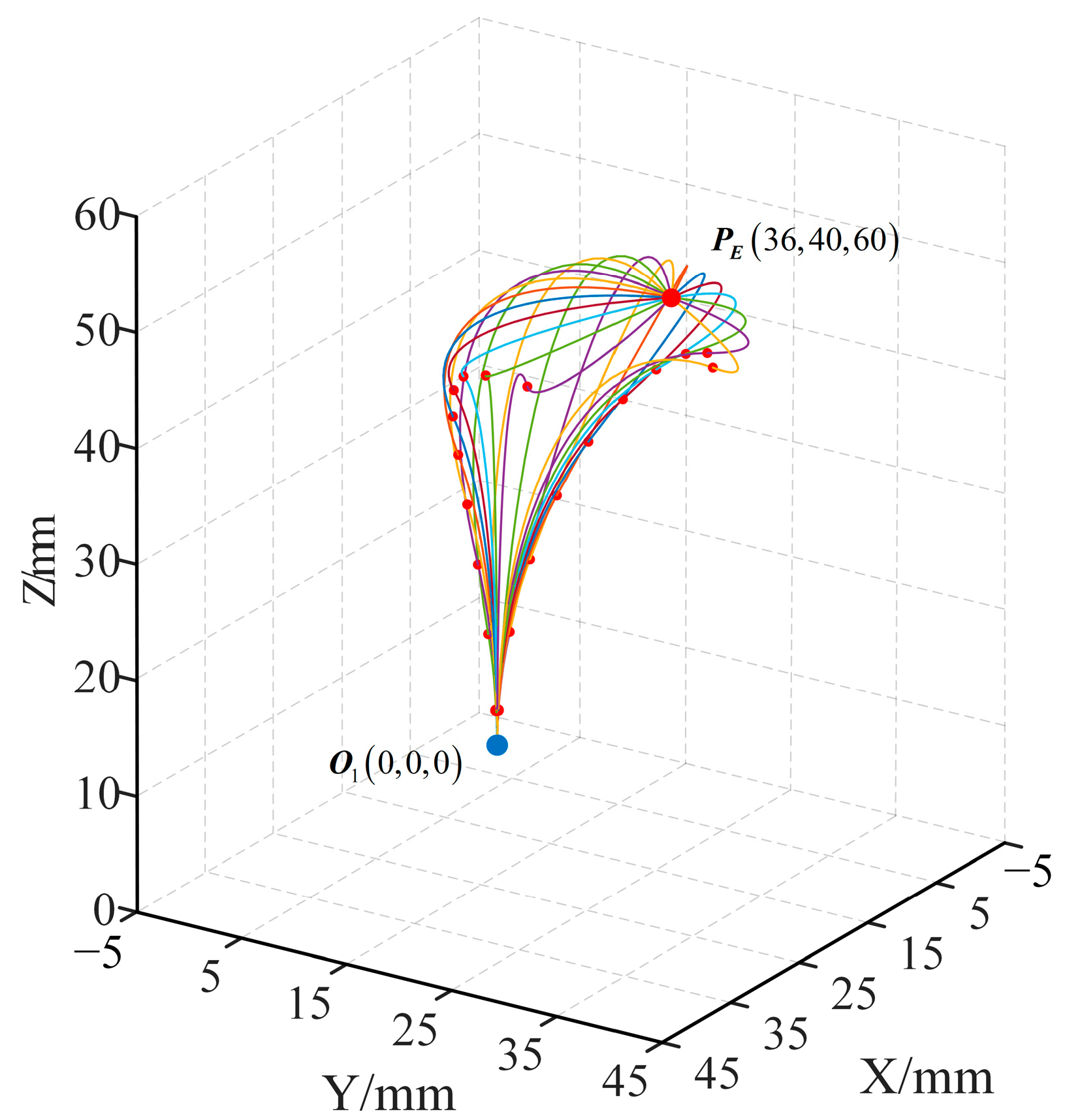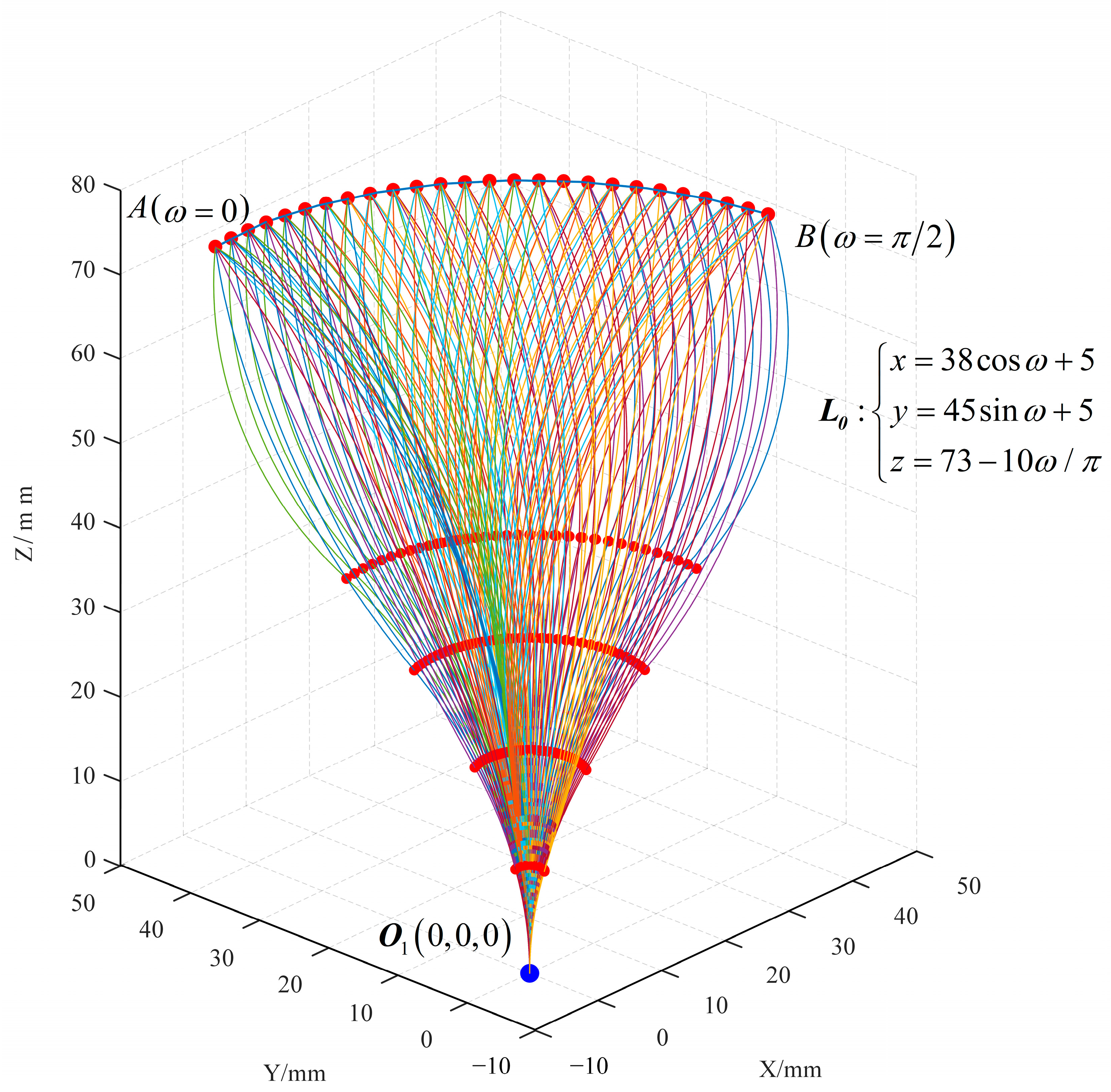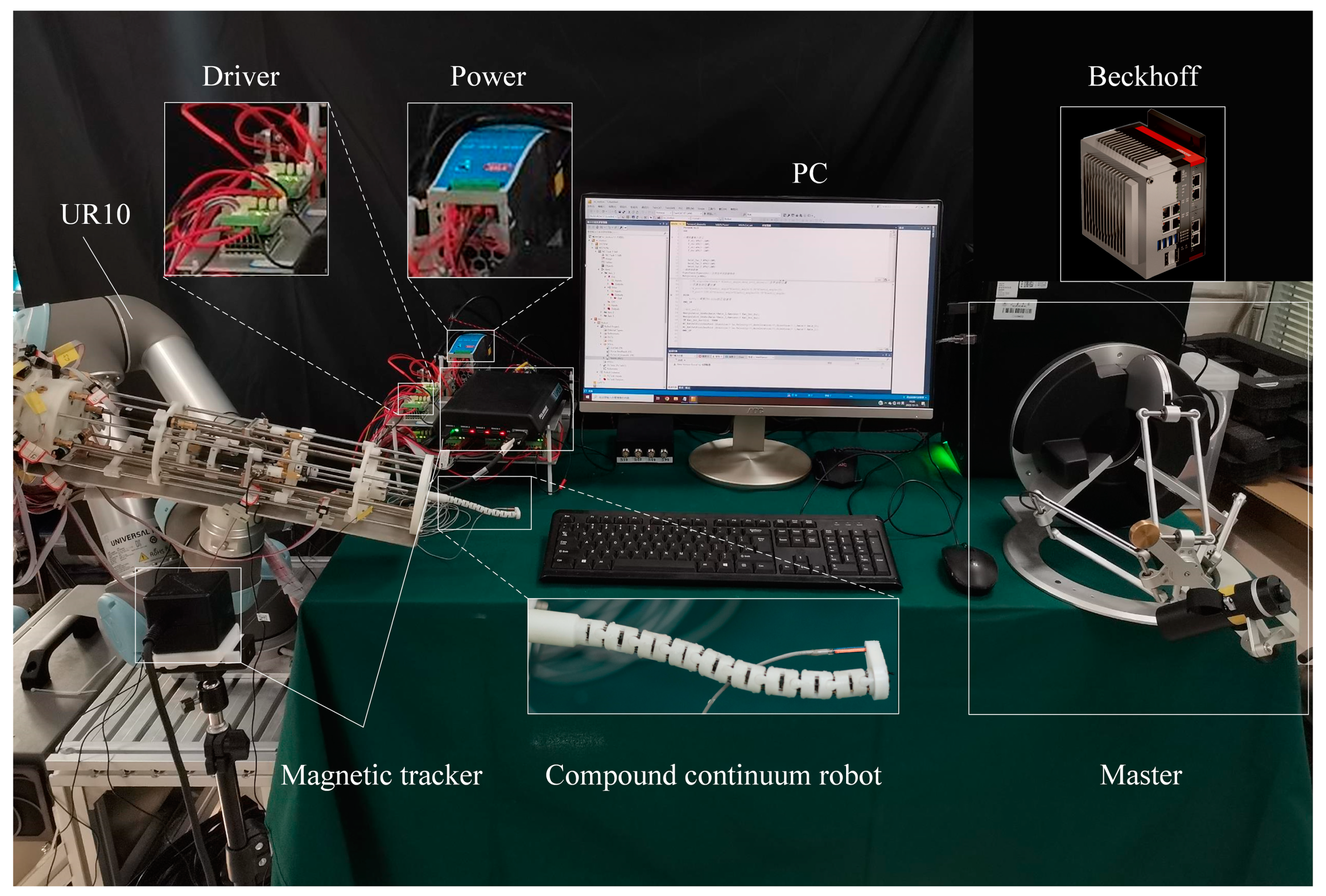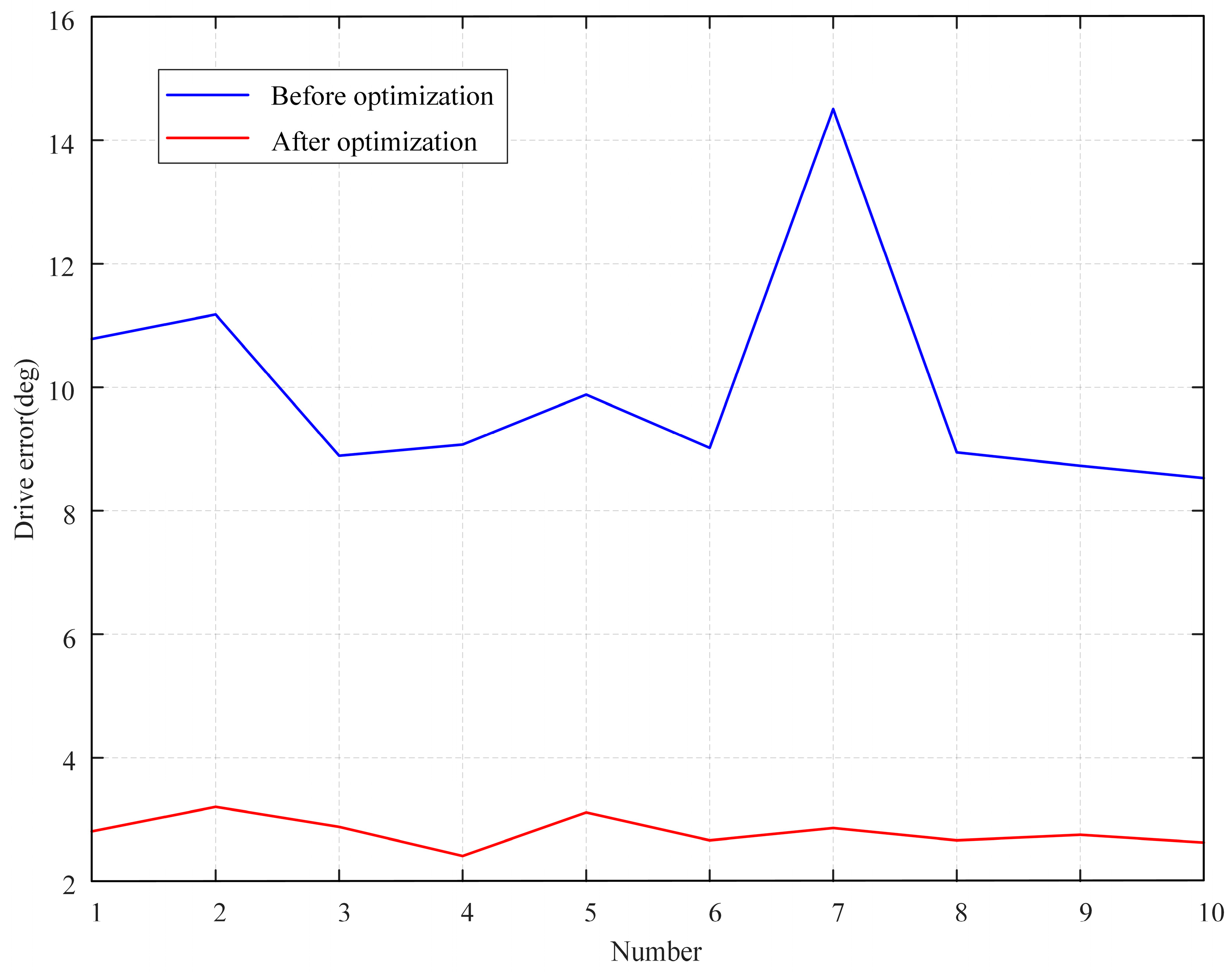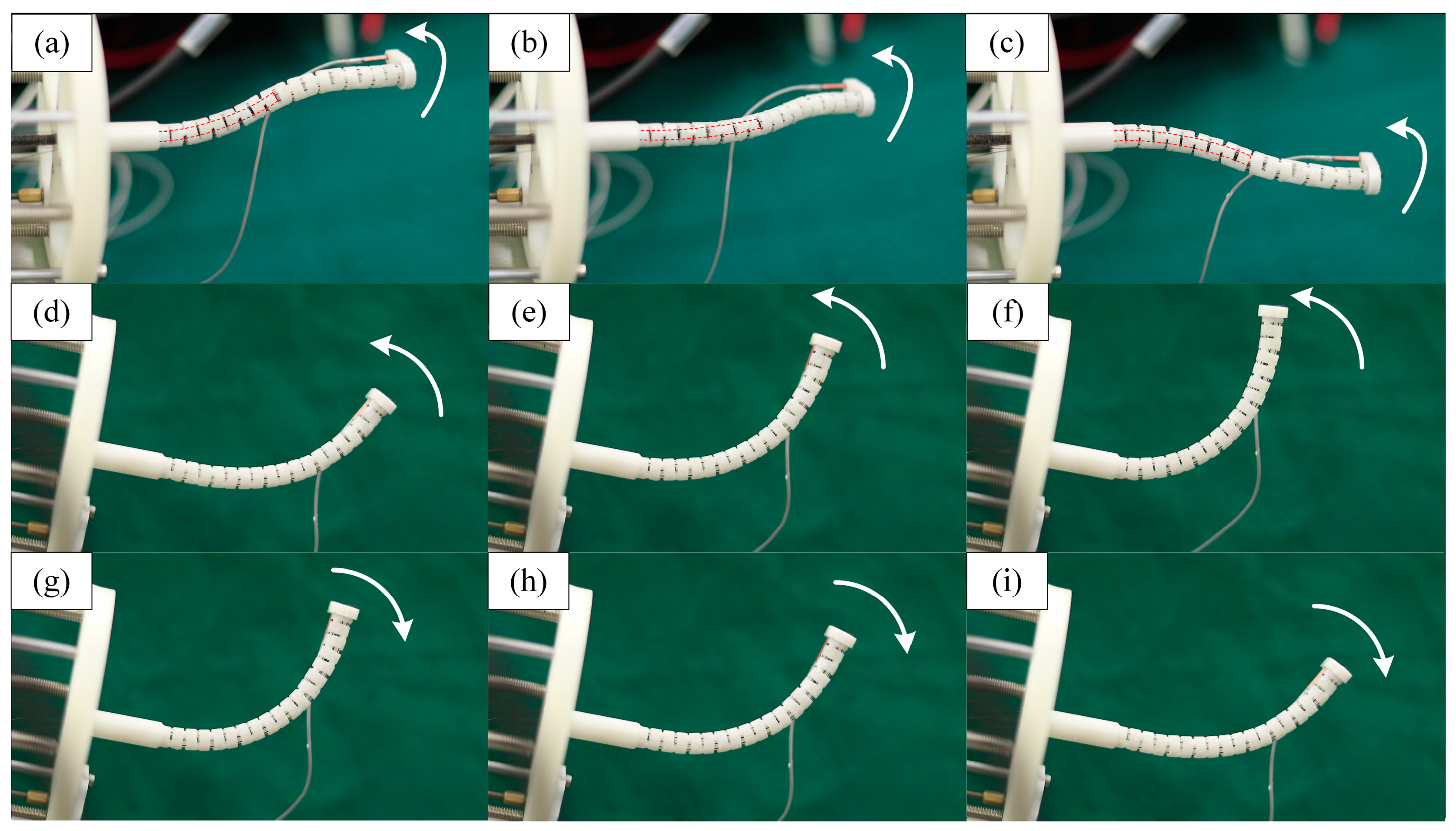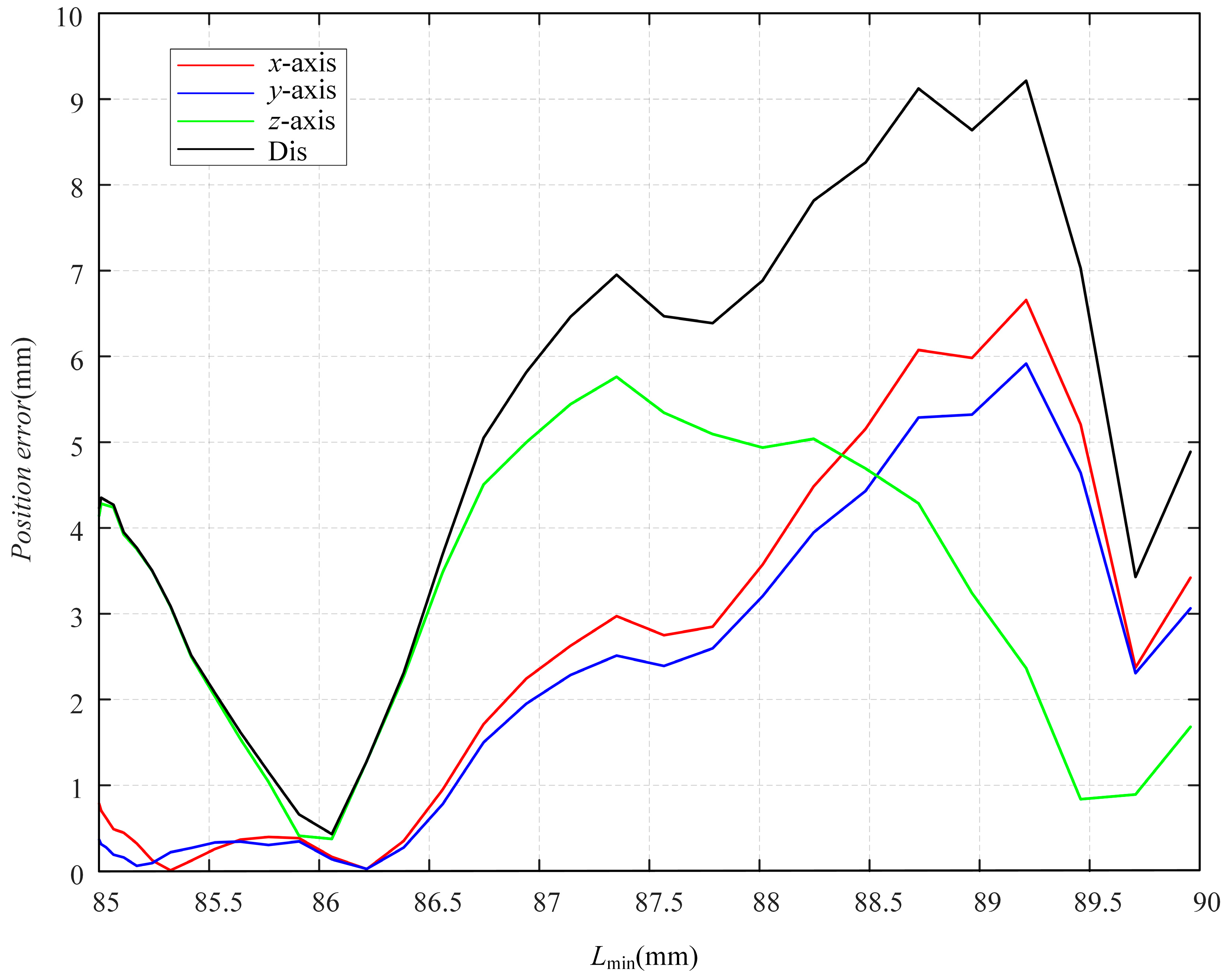In this paper, a kinematic model is developed under the assumption of constant curvature. In contrast to previous studies, the coupling effect between the concentric tube and the cable-driven continuum is utilized to accomplish precise manipulation of the robot. To exploit this coupling effect effectively, the range of motion of the concentric tube is confined within the cable-driven continuum. Due to the significant stiffness of the concentric tube, the influence of the cable-driven continuum on the stiffness of the concentric tube is negligible.
In
Figure 3, the
O1O2 section represents the compound part, while the
O2PE section represents the cable-driven continuum part. The total length of the robot is denoted by
L, and the concentric tube is characterized by a preset curvature
k. During operation, the concentric tube feeds a length
s into the cable-driven continuum and then undergoes rotation by an angle
ϕ1. As presented in
Figure 3, the
O1O2 section has a length
s, a rotation angle
ϕ1, and a bending angle
sk. On the other hand, the length of the
O2PE section is
L −
s, with the deflection angle around the
Z2-axis as
ϕ2, and the bending angle being
θ.
Traditional methods generally use the Denavit–Hartenberg (DH) method to establish the kinematic model and then solve the inverse kinematics using the Levenberg–Marquardt (LM) method [
25,
26]. The LM method obtains the result through a series of matrix iterations and is widely used. For the compound continuum robot described in this paper, after establishing the kinematic model using the DH method, the LM method is used to solve the matrix equation containing the variables
s,
ϕ1,
ϕ2, and
θ. However, this method has a slow solving speed. In this paper, a new kinematic model is established, and a new inverse kinematics algorithm is designed. Through simple analysis, a system of equations to be solved is obtained. By using polynomial fitting, the solution of a system of equations is transformed into the solution of an equation with two variables. Then, the Newton iteration method is used to quickly solve it. This algorithm greatly improves the solving speed while ensuring the accuracy of the solution.
4.1. Forward Kinematics Model
When
s,
ϕ1,
ϕ2, and
θ are all known quantities, the position of
PE on the world coordinate system
O1-
X1Y1Z1 is as follows:
where
x,
y, and
z are functions with respect to
L,
k,
s,
ϕ1,
ϕ2, and
θ. The expressions of
x,
y, and
z can be derived by the following matrix transformation analysis.
As shown in
Figure 3, the position of
PE of the compound continuum robot on the relative coordinate system
O2-
X2Y2Z2 is as follows:
The position of
PE on
O1-
X1Y1Z1 is
and on
O2-
X2Y2Z2 is
. They include the following relationship:
where
and
are the rotation and translation matrices relative to the coordinate system
O2-
X2Y2Z2, respectively. From this, the expressions of (5) with respect to
L,
k,
s,
ϕ1,
ϕ2, and
θ can be obtained as follows:
where c
sk = cos
sk, s
sk = sin
sk, c
θ = cos
θ, s
θ = sin
θ, c
ϕ1 = cos
ϕ1, s
ϕ1 = sin
ϕ1, c
ϕ2 = cos
ϕ2, and c
ϕ2 = cos
ϕ2, which are the same as below.
Substituting (3) and (4) into (8) yields the coordinates of
PE versus (
s,
ϕ1). From this, the motion space when controlling the robot using coupled motion can be obtained, as shown in
Figure 4. The relevant parameters of this simulation experiment are shown in
Table 2. It can be seen that it is feasible to control the motion of the robot by the coupling.
4.2. Inverse Kinematics and Its Algorithm
The process for obtaining the inverse kinematic solution of the robot is illustrated in the flowchart presented in
Figure 5.
The following is a detailed description of
Figure 5.
As shown in
Figure 3, the position of
PE on the world coordinate system
O1-
X1Y1Z1 is expressed by (5), and when
x,
y, and
z are known quantities in (5), then (
s,
ϕ1,
ϕ2,
θ) can be obtained from the inverse kinematic analysis.
From Equation (6), it is easy to obtain
From the geometric relationship, it is easy to obtain
As shown in
Figure 3, the position of
PM of the compound part on the world coordinate system
O1-
X1Y1Z1 can be expressed as
From (11), the following can be obtained:
When , y1 ≥ 0, and when , y1 < 0. Due to the symmetry of the two cases in (13), the analysis in the case at y1 ≥ 0 is enough.
With (12) and (13), the rotation matrix
can be expressed as
where
,
.
Combining (5), (11), and (15), the results can be obtained as
Combining (13), (14), and (16), thus eliminating
y1 and
z1 in (16), the result can be obtained as
From (6), the workspace of
PE on the relative coordinate system
O2-
X2Y2Z2 is a surface formed by rotation around the
Z2-axis, and this surface can be expressed by the implicit equation:
From (6), the following can be obtained:
From (19) and (20), it can be obtained that the relationship between
and
z2 is independent of
ϕ2, so the implicit equation on the coordinate system
R-
O-
Z2 can be established as
where
. Since this implicit equation is difficult to solve, it is necessary to choose a simple curve to replace this equation. When
, this curve varies with
s. This curve is related to the position of
, and it is equivalent to the end position curve of the cable-driven continuum robot of length (
L −
s) in bending motion in any plane. The curve can be fitted as
where
ai is the coefficient obtained from the fit, which is obtained by solving the following equation:
where
where
,
, and
N is a sufficiently large positive integer. From this, the implicit equation for
x1 and
s can be obtained as
where
. And
x2,
y2, and
z2 are defined by (17).
Each substitution of a value of
s is re-fitted, and this method is obviously very tedious. Therefore, (22) is changed to
where
Ai is the coefficient obtained from the fit, which is obtained by solving the following equation:
where
The fitting coefficient is solved as
However, (19) and (20) are derived based on the theoretical derivation of constant curvature, and the factors of torsion, friction, shear, and axial elongation are not considered in the modeling process. So, the fitting coefficients can easily cause large errors when solved by this method. Therefore, in this paper, the actual end coordinates are used as the fitting data by experimental method to reduce the fitting errors. The end coordinate (xi, yi, zi) of the cable-driven continuum robot with length L is obtained experimentally, and let L = 90 mm. In the experimental process, the end curve of the cable-driven continuum robot is changeable when it is gradually bent and when it is gradually straightened due to the change of friction direction, so two sets of fitting coefficients are obtained.
When the cable-driven continuum robot is gradually bent, the fitting coefficient is as follows:
When the cable-driven continuum robot is gradually straightened, the fitting coefficient is as follows:
From this, the implicit equation for
x1 and
s can be obtained as
where
. And
x2,
y2, and
z2 are defined by (17). By inputting the value of
s, the following equation can be obtained:
The multiset (s, x1) can be obtained by Newton’s iteration method. The s and x1 obtained from the solution are input into (13) and (12) in turn to obtain the rotation angle ϕ1 of the compound part, and the coordinate values of are obtained by inputting the solutions into (17); then, ϕ2 and θ are obtained from (9) and (10), respectively.
